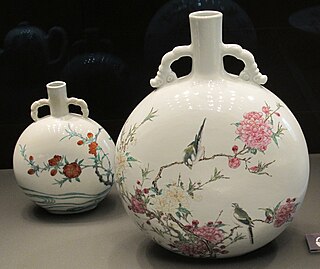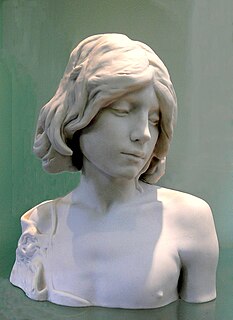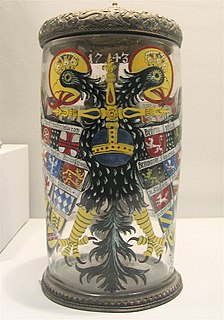Related Research Articles

Vitreous enamel, also called porcelain enamel, is a material made by fusing powdered glass to a substrate by firing, usually between 750 and 850 °C. The powder melts, flows, and then hardens to a smooth, durable vitreous coating. The word comes from the Latin vitreum, meaning "glass".

A whiteboard is a glossy, usually white surface for making nonpermanent markings. Whiteboards are analogous to blackboards, but with a smoother surface allowing rapid marking and erasing of markings on their surface. The popularity of whiteboards increased rapidly in the mid-1990s and they have become a fixture in many offices, meeting rooms, school classrooms, and other work environments.

Cloisonné is an ancient technique for decorating metalwork objects with colored material held in place or separated by metal strips or wire, normally of gold. In recent centuries, vitreous enamel has been used, but inlays of cut gemstones, glass and other materials were also used during older periods; indeed cloisonné enamel very probably began as an easier imitation of cloisonné work using gems. The resulting objects can also be called cloisonné. The decoration is formed by first adding compartments to the metal object by soldering or affixing silver or gold as wires or thin strips placed on their edges. These remain visible in the finished piece, separating the different compartments of the enamel or inlays, which are often of several colors. Cloisonné enamel objects are worked on with enamel powder made into a paste, which then needs to be fired in a kiln. If gemstones or colored glass is used, the pieces need to be cut or grinded into the shape of each cloison.

Uranium glass is glass which has had uranium, usually in oxide diuranate form, added to a glass mix before melting for coloration. The proportion usually varies from trace levels to about 2% uranium by weight, although some 20th-century pieces were made with up to 25% uranium.

In different periods of time and in different countries the word majolica has been used for two distinct types of pottery.

Famille jaune, noire, rose, verte are terms used in the West to classify Chinese porcelain of the Qing dynasty by the dominant colour of its enamel palette. These wares were initially grouped under the French names of famille verte, and famille rose introduced by Albert Jacquemart in 1862. The other terms famille jaune (yellow) and famille noire (black) may have been introduced later by dealers or collectors and they are generally considered subcategories of famille verte. Famille verte porcelain was produced mainly during the Kangxi era, while famille rose porcelain was popular in the 18th and 19th century. Much of the Chinese production was Jingdezhen porcelain, and a large proportion were made for export to the West, but some of the finest were made for the Imperial court.

Pressed glass is a form of glass made using a plunger to press molten glass into a mold. It was first patented by American inventor John P. Bakewell in 1825 to make knobs for furniture.

Carnival glass is moulded or pressed glass to which an iridescent surface shimmer has been applied.
Satin glass is a piece of glass that has been chemically treated to give it a satin finish. The term "satin glass" is frequently used to refer to a collectible type of pressed glass.

Depression glass is glassware made in the period 1929–1939, often clear or colored translucent machine-made glassware that was distributed free, or at low cost, in the United States and Canada around the time of the Great Depression. Depression glass is so called because collectors generally associate mass-produced glassware in pink, yellow, crystal, and green with the Great Depression in America.

Biscuit porcelain, bisque porcelain or bisque is unglazed, white porcelain treated as a final product, with a matte appearance and texture to the touch. It has been widely used in European pottery, mainly for sculptural and decorative objects that are not tableware and so do not need a glaze for protection.

Ceramic glaze is an impervious layer or coating of a vitreous substance which has been fused to a ceramic body through firing. Glaze can serve to color, decorate or waterproof an item. Glazing renders earthenware vessels suitable for holding liquids, sealing the inherent porosity of unglazed biscuit earthenware. It also gives a tougher surface. Glaze is also used on stoneware and porcelain. In addition to their functionality, glazes can form a variety of surface finishes, including degrees of glossy or matte finish and color. Glazes may also enhance the underlying design or texture either unmodified or inscribed, carved or painted.
This is a list of pottery and ceramic terms.

The Fenton Art Glass Company is a glass manufacturer founded in 1905 by brothers Frank L. Fenton and John W. Fenton.
The Westmoreland Glass Company was a company that produced glass in Grapeville, Pennsylvania.

Elegant glass is high quality glassware created in the United States during the Depression Era. It was sold for high prices in department stores and given as wedding gifts. When new, Elegant glass would cost more than its oft-confused counterpart, Depression glass, because it was at least partially handmade, had a cleaner finish, and more vibrant colors. From the 1920s through the 1950s, Elegant glass was an alternative to fine china. Most of the Elegant glassware manufacturers closed by the end of the 1950s, and cheap glassware and imported china took its place.
Early American molded glass refers to functional and decorative objects, such as bottles and dishware, that were manufactured in the United States in the 19th century. The objects were produced by blowing molten glass into a mold, thereby causing the glass to assume the shape and pattern design of the mold. Common blown molded tableware items bearing designs include salt dishes, sugar bowls, creamers, celery stands, decanters, and drinking glasses. Household items, other than dishware, made using the three-mold method include inkwells, oil lamps, birdcage fountains, hats, medicine and perfume bottles, and witch balls. Whiskey flasks bearing unique designs were made in two part molds. Undecorated bottles used as containers for a variety of liquids were blown into square molds to give them corners so they could be packed into compartments of wooden cases.

China painting, or porcelain painting, is the decoration of glazed porcelain objects such as plates, bowls, vases or statues. The body of the object may be hard-paste porcelain, developed in China in the 7th or 8th century, or soft-paste porcelain, developed in 18th-century Europe. The broader term ceramic painting includes painted decoration on lead-glazed earthenware such as creamware or tin-glazed pottery such as maiolica or faience.

Enamelled glass or painted glass is glass which has been decorated with vitreous enamel and then fired to fuse the glasses. It can produce brilliant and long-lasting colours, and be translucent or opaque. Unlike most methods of decorating glass, it allows painting using several colours, and along with engraving, has historically been the main technique used to create the full range of image types on glass.
Indiana Glass Company manufactured pressed, blown and hand-molded glassware and tableware for almost 100 years. Predecessors to the company began operations in Dunkirk, Indiana, in 1896 and 1904, when East Central Indiana experienced the Indiana gas boom. The start date for the company is considered 1907, when a group of investors led by Frank W. Merry formed a company to buy the Dunkirk glass plant that belonged to the bankrupt National Glass Company. National Glass was a trust for glass tableware that originally owned 19 glass factories including the plant in Dunkirk. National Glass went bankrupt in 1907, and its assets were sold in late 1908.
References
- McKinley, Carolyn (January 1984). Goofus Glass: An Illustrated Value Guide. Collector Books. p. 128. ISBN 978-0-89145-251-5.